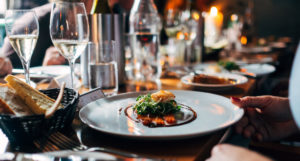Translation and localisation specialist Version internationale is here to take you on a journey through the flavoursome realm of gastronomy by shedding some light on culinary translation. Discover how to turn a good translation into a commercial asset, as well as the mistakes to avoid when choosing your service provider.
Culinary translation encompasses several types of categories, with the translation of menus, recipes, product presentations and even nutritional advice.
For professionals in the catering industry, providing a menu in several languages quite simply expands their potential customer base. France, the most popular tourist destination in the world, was visited by around 89 million tourists in 2017. Many come to enjoy France’s culinary arts and local produce. However, the linguistic barrier, or even a clumsy translation, can sometimes spoil this experience and even drive away the customer. So, maximise your chances and invest in a high-quality culinary translation!
Translations… without translators?
The first stumbling block to avoid is the temptation to use automatic translation tools, such as Google Translate. They are fast and free, but they give no guarantee of quality and, worst still, can add mistakes. This is how most of the Internet’s hilarious culinary translations, which were not actually the work of translators, were created. And when jam turns into “traffic”, oil turns into “fuel” and even “egg” turns into “foetus”, it is your brand’s image that suffers and your customer who loses his or her appetite…
Contact a specialist
Using genuine, professional translators is particularly important since culinary translation is a lot more complicated that it seems.
Thanks to its partnerships with large groups, such as Air France, Weight Watchers and also restaurant owners and producers, Version internationale and its translation teams have gained valuable experience in this field. Adriane, a linguist specialising in culinary translation at Version internationale, explained why this field is special:
“A country’s cuisine is closely connected to its culture. Not only is the vocabulary very specific, but the register of the language used varies a lot from language to language. In France, we use lots of metaphors and rather literary phrases to present our cuisine. Foreign translators therefore need to draw on all their experience to produce a text that can be easily understood by customers while preserving the distinctive features of the dish and culinary culture.
Even simple ingredients, like clotted cream, cottage cheese and piccalilli pickles, can be problematic for inexperienced translators. So, when you say “pigs in blankets”, “bear claw” or even “cheesesteak”, a literal translation is not always possible, and in reality, their common equivalents are approximations, because these dishes are typically English. You therefore need translators who are both rigorous and inventive, and who have a very sound knowledge of gastronomy in England and abroad.”
Cooperation between the translator and the professional
One of the main challenges in culinary translation is satisfying the needs of the client, as well as the customer. Mainstream restaurants therefore need to use language that is clear, easy and straightforward for as many people as possible.
On the other hand, gourmet cuisine uses products that are rarer and more specific. It is, therefore, important to make sure that gastronomes can detect these intricacies. Furthermore, in this context, the culinary experience often begins from the moment they read the menu. Flowery and poetic descriptions concocted by the chefs set the customer’s taste buds tingling. The translator therefore needs to create a similar experience for foreign customers.
Our experience at Version internationale has shown us that close cooperation with chefs and producers is a major asset for producing translations that are well-adapted to the strategic positioning of these professionals and respectful of their expertise. Our translations are part of their development strategy, and they enable them to establish unique bonds of trust with their customers.
If you require culinary translations, we can help you find the best solution; just contact us!


